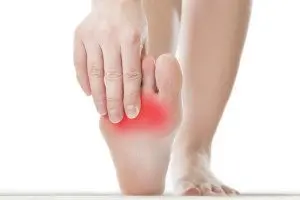Contents
Metatarsalgia: how to treat it?
We speak of metatarsalgia in pain in the forefoot. The causes are numerous and only a precise diagnosis will make it possible to find the origin and thus offer a targeted treatment? Update on this not so rare pathology.
What is metatarsalgia?
Metatarsalgia, is a general term that describes pain under the forefoot, between the arch of the foot and the toes, most often located at the end of a bone called the “metatarsal”. The metatarsals are therefore the bones that articulate with the toes on which we lean. If the weight is not evenly distributed, the person may feel pain in a very localized area or all over the forefoot. Often, this imbalance is responsible for a reaction thickening of the skin (callus).
What are the causes of metatarsalgia?
The causes of metatarsalgia are multiple, but it is mainly a problem of weight distribution over part or all of the front of the foot at the level of the 5 metatarsal heads. Any imbalance triggers a modification and therefore an overload on one or more metatarsals.
Here are different problems that lead to consultation:
- Bad length of a metatarsal (a short or long 1st metatarsal, a too long 2nd metatarsal);
- Have flat or sagging feet;
- Have a hollow foot, with verticalization of the metatarsals;
- Have limited ankle flexion due to an Achilles tendon that is too short;
- Suffer from hallux valgus;
- Pain in the metatarsal joint;
- Too long metatarsals (propulsive metatarsalgia – metatarsalgia related to an architectural anomaly of the forefoot).
Here are different factors that can increase the situation:
- Wearing shoes that are too tight in the forefoot, poorly adjusted, having a lack of absorption of the sole or being too flexible;
- Wearing too high heels which increase the speed of onset of pain;
- Overweight and significant and rapid weight gain;
- Excessive and too rapid practice of sport with impacts (running, walking, etc.);
What are the symptoms of metatarsalgia?
Metatarsalgia is manifested by pain located under the sole of the foot at the base of the toes. This pain appears during exertion, making everyday activities relatively disabling since they can interfere with it and it disappears during periods of rest such as sleep.
The most representative sensations are:
- Diffuse burning sensation;
- Numbness in the front of the feet;
- Swelling on the top and front of the feet;
- Presence of calluses on the front of the feet;
- Difficulty squatting on the front of the foot;
- Slenderness to the phalanges of the foot;
- When the metatarsalgia is very advanced, the pain can appear more quickly.
How to treat metatarsalgia?
Some medical treatments may decrease the pain or provide temporary comfort, but it will not correct the cause of the pain. Surgery may be considered if the pain and functional discomfort are too severe.
Medical treatment
Start by reducing activities that involve a lot of walking and focus on sports without full load on the feet (cycling and swimming). Then, move on to pedicure care, and wearing orthopedic insoles. Appropriate rehabilitation can provide more lasting relief from painful phenomena. Pain relievers, muscle relaxers and / or anti-inflammatories may be prescribed to help control inflammation. If necessary, significant weight loss should be considered.
Surgical treatment
The surgical treatment will focus on finding a more harmonious distribution of the body’s weight on the forefoot. This harmony aims to match the lengths of the metatarsals, but also their support on the ground.
Two surgical techniques exist and the choice will be made according to the foot to be operated on:
- Minimally invasive osteotomy (breakage): we make a small opening of five millimeters (percutaneous). We do not put screws and we always break several metatarsals because the fact of leaning on the foot after the operation will allow all the bones to consolidate naturally with a better distribution of the weight on the foot. This technique is called DMMO: Distal Minimally invasive Metatarsal Osteotomy;
- Weil’s osteotomy: called “open”, fixed by a screw. It is necessary to make an incision of about 2 centimeters, the purpose of which is a shortening and / or an elevation of the heavier heads.
Prevention of metatarsalgia
It is not always possible to prevent metatarsalgia. However, choose the right footwear, making sure:
- Wide shoe (plenty of room for the foot) this will help your foot not to receive unnecessary pressure;
- A slight heel;
- Well-cushioned and solid shoes;
- A good sole not too thin, heel and of adequate width;
- Renew their shoes and work boots annually;
- Wear your prescribed orthotics daily;
- Lose weight if needed;
- Pay attention and change your working position frequently when necessary (avoid keeping your toes in hyperextension);
- Renew your running shoes: every 800-1000 km run, if there is a deterioration, if you wear lighter shoes; if you are bigger you may have to change them every 500-700 km.










